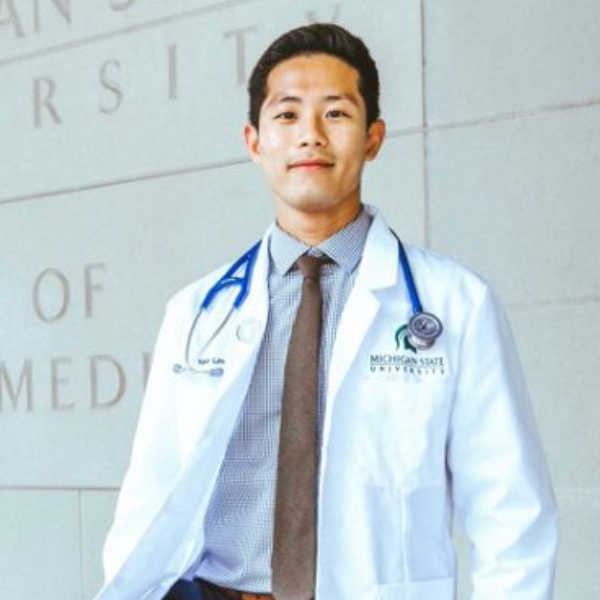Dean's Update
May 31, 2024 - Aron Sousa, MD

Team Sparty! Aron with PGY-2 Saif AlAttal, MD, and PGY1 Lalitsiri Atti, MD, and again with PMR PGY-1 Amy Drabant, DO. These residents did a great job, and we really enjoyed taking care of patients together.
Friends,
Early in the week, we welcomed President Kevin Guskiewicz and his wife, Amy, to the Grand Rapids Research Center (GRRC) and the Doug Meijer Medical Innovation Building (DMMIB). As with his visit in East Lansing, it was clear just how much the president appreciates being with our researcherd in the GRRC and our collaborating partners in the DMMIB. My thanks to all the faculty who met with them and all the people who made the visit so successful. The full Board of Trustees and presidential retinue will visit Flint at the end of June for the board’s annual retreat. I am excited for that visit, too!
I have been enjoying a fortnight of rounding with our wonderful residents on the Department of Medicine’s inpatient service. Each rotation seems to have something of a theme, thanks mostly to cognitive bias. Team Sparty has been all about the kidneys for the last two weeks. Ok, that’s not strictly true. We’ve treated patients with heart attacks, cancer, strokes, COVID-19, and all the usual ailments on a medicine service, but there were so many urinary issues this time that I counted them. With a few days to go, 37% of our patients had renal cause for their chief complaint. I’ve never tracked that before, but its seems a bit high.
Ergo, I poked around the literature a bit, and I discovered that hospitalization for urinary tract infections (UTI) may be increasing. Not all our patients had UTIs, but many did. The working hypothesis for the increase in hospitalizations from UTIs is more antibiotic resistance that consequently require more intravenous antibiotics to successfully control the infection. Antibiotic resistance is clearly increasing across the globe, and our team had a patient whose urine grew vancomycin resistant enterococcus, extended spectrum beta-lactamase (ESBL) E. coli, and multidrug resistant Klebsiella. That’s a real handful to treat. What once might have been a UTI suitable for outpatient treatment now requires inpatient treatment and an infectious disease consultant. Our little convenience sample of patients does not prove anything, and nor does that paper, but it does engage the little grey cells. (I think Ms. Christie is pulling our lariat.)
The increase in UTI hospitalizations is probably also in part due to the aging of the population. Older people get more UTIs and get sicker from them. More old folks mean more UTIs in the hospital. There are also more people with diabetes and other conditions that predispose to UTIs. Our patients included several bladder and kidney cancer survivors, who no longer have normal urinary anatomy and often have tubes and stents and need urinary procedures, all of which increase the chances of infection. As more and more people survive bladder and kidney cancer, there will be more people whose anatomy puts them at increased risk of UTIs. A couple of our patients did not have good home situations, which makes it difficult to access outpatient care. More homelessness and poor access will increase UTI hospitalizations. There are also more UTIs in the summer when it is hotter, which is not explanation for Team Sparty’s experience, but climate change may have an impact over time. There are so many reasons hospitalizations could be going up.
Critical thinkers will note that our blip of urinary patients may not reflect any change in disease. We could just be seeing random variation, or perhaps local urologists have stopped admitting as many of their patients and are asking the internal medicine teams to admit more of their patients. So, there may not be more patients but rather a shift in who is caring for them. Data like I’ve given you can be really misleading. Perhaps the relative increase in urology patients (I did give you a percentage) has nothing to do with more renal system patients, but rather we are seeing fewer patients with other problems. I think this is one of the most interesting ways we get fooled by data. Sometimes we are not seeing more of a problem; sometimes we are missing a population in the control who we should be counting. The last couple of weeks have been very quiet with relatively few patients on the service (sorry, Chaz), so perhaps we are somehow missing people with other conditions. For example, we only had a couple of patients with gastrointestinal disease, and those missing folks make it seem like there are more urinary patients. It can be so difficult to see the data you are missing.
What I do see are all the people doing the work that makes the college hum. I see residents caring for patients who do not have a regular physician. I see alumni from all our degrees, who bring science and humanism to our understanding of the world. I see staff who get our students enrolled, create our grant budgets, put us in compliance, and keep our programs afloat. I see students developing the skills to change the course of people’s lives, and I see faculty, so many faculty, who dedicate their careers to pushing back the frontiers of their field and developing the next generations who will follow them.
That is a lot to see. For the individuals and families we help, they may only see a small group of us moving from room to room, listening and asking a few questions, sorting through data and findings, trying our best to understand their goals and find a path for them to achieve those goals. There is so much to see in the college, but for those we help, that small group shuffling along a hallway is enough.
Serving the people with you,
Aron
Aron Sousa, MD, FACP
Dean, Michigan State University College of Human Medicine


